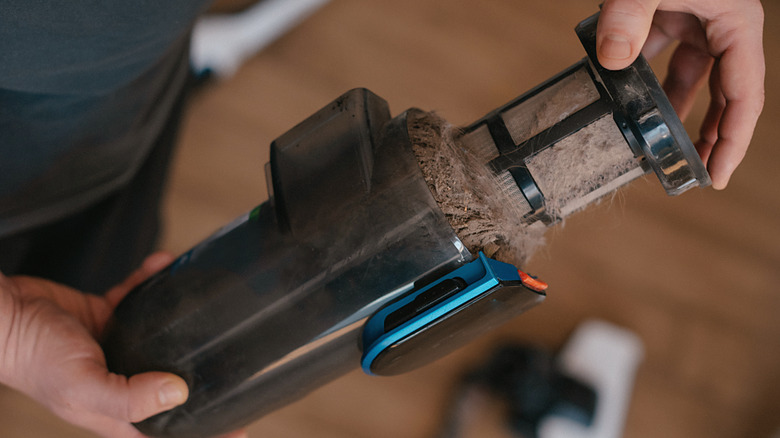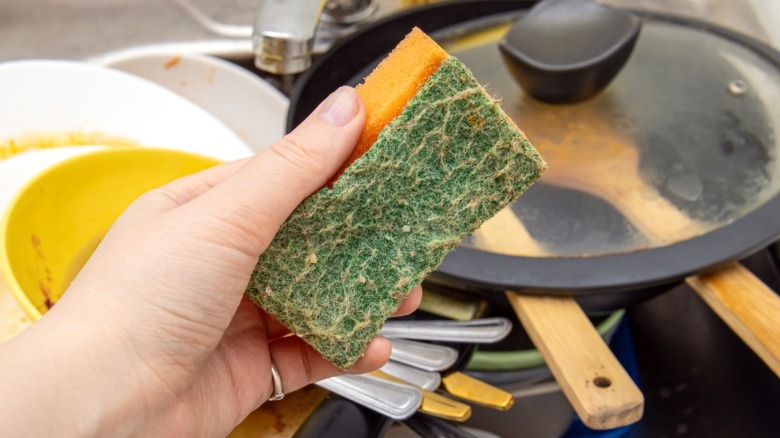Don't Make This Mistake If You Want A Cleaner And Healthier Home
Spraying disinfectant, wiping down counters, and scrubbing floors and crevices are important in maintaining a clean and healthy home. But one surprisingly common mistake can sabotage all of your hard work: cleaning with dirty tools. Even if you have all of the most genius cleaning tools for your home, they're kind of pointless if you're not keeping up with their maintenance.
An old, grimy sponge, a mop that hasn't been washed, or a vacuum that hasn't had its filter emptied and cleaned are only a few of the things that can make your cleaning efforts a lot less effective. What's even worse is that you may be spreading dirt and germs all throughout the house. Tools like sponges and mop heads require regular washing, disinfecting, or replacement to avoid harboring mildew and bacteria. You may even be surprised to learn cleaning experts told Consumer Reports that replacing kitchen sponges every one to two weeks, microfiber cloths every six months to a year, and mops every three to six months is ideal. So, how you clean your cleaning supplies is another crucial step in maintaining a tidy and healthy home.
Simple habits that keep your cleaning tools fresh
When you're finished with your cleaning chores, implementing a couple of maintenance steps in your routine will help you avoid replacing tools prematurely and stop germs from spreading. As soon as you're finished using your cleaning tools, rinse your sponges and microfiber towels in hot water, and squeeze them out. Soak heavily soiled mop heads in a bucket of cleaning solution. For light cleaning, just rinse them under running water. Drying is the most important for both sponges and mop heads. It's critical to let sponges and mop heads dry in a well-ventilated area.
For vacuums, make sure to clean the filter when you empty it, and inspect the brush rolls for tangled hair and other debris. Also, make sure to avoid the most common mistakes that are slowly killing your vacuum cleaner. A clogged filter, a dirty brush roll, and overlooking regular upkeep of your vacuum can reduce suction power and overwork it, ultimately shortening its lifespan. These simple habits will keep your cleaning tools in great condition and help you have a home that's not just sparkly and shiny but also cleaner and healthier.
Signs your cleaning tools are ready for replacement
While cleaning and reusing your supplies can help them last longer, it's key to know when your tools need to be replaced. For instance, if your sponge looks grimy or has a foul smell, it's time to throw it out. Charles Gerba, a microbiologist and professor at the University of Arizona, told Good Morning America, "Odor is one indicator. Certain bacteria cause the odor in sponges, and that increases with age. Also, when the edges start looking worn, it's a good sign to toss it." Until they need replacing, you can clean sponges effectively by soaking them in a solution of water and bleach, microwaving them for 20 seconds, or washing them in the washing machine.
With mops, cleaning experts say replacement timelines depend heavily on the material of the mop and how often they're used. Traditional string mops should be replaced every two to three months, though you can swap them more frequently if they regularly take on high-traffic or significantly dirty areas. Steam mops, on the other hand, have the advantage of sanitizing the mop head as it's being used, thanks to the high heat component. However, a downside of steam mops is that the heat can also damage the fibers more quickly, so these will need replacement after only about 20 uses or so.


